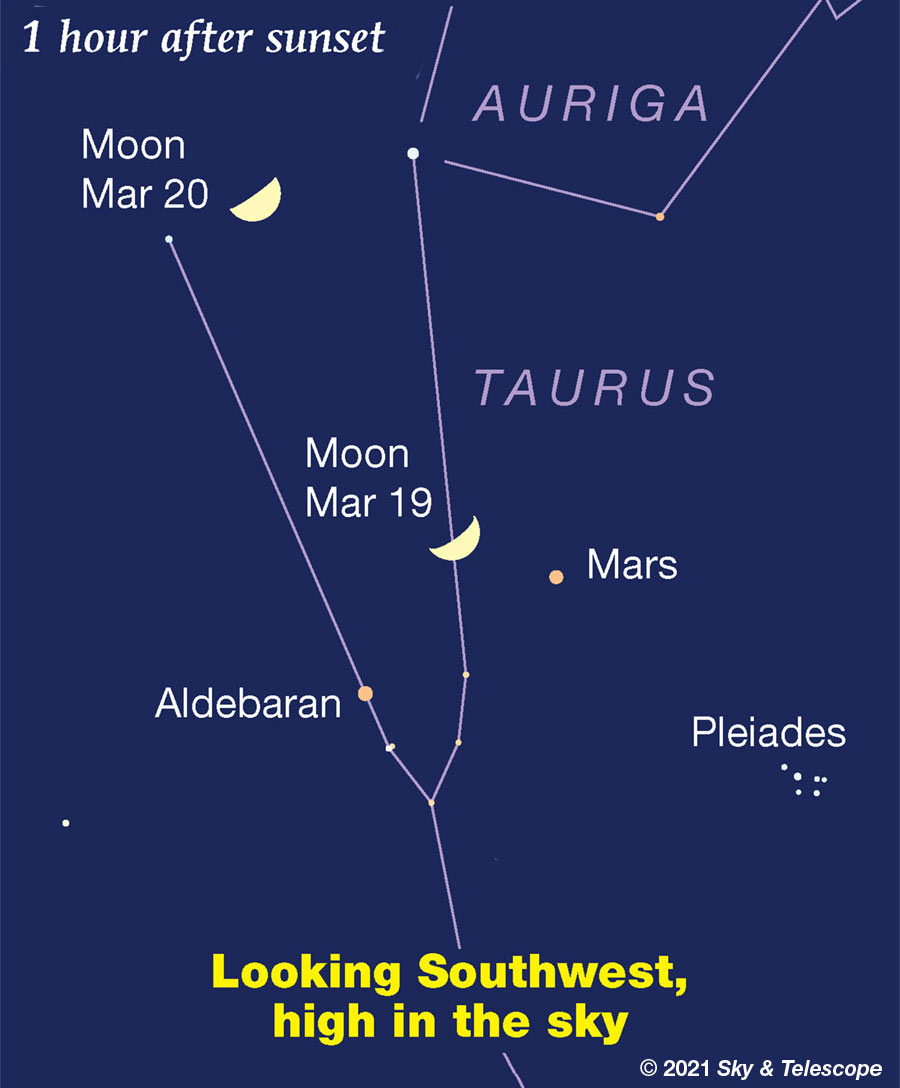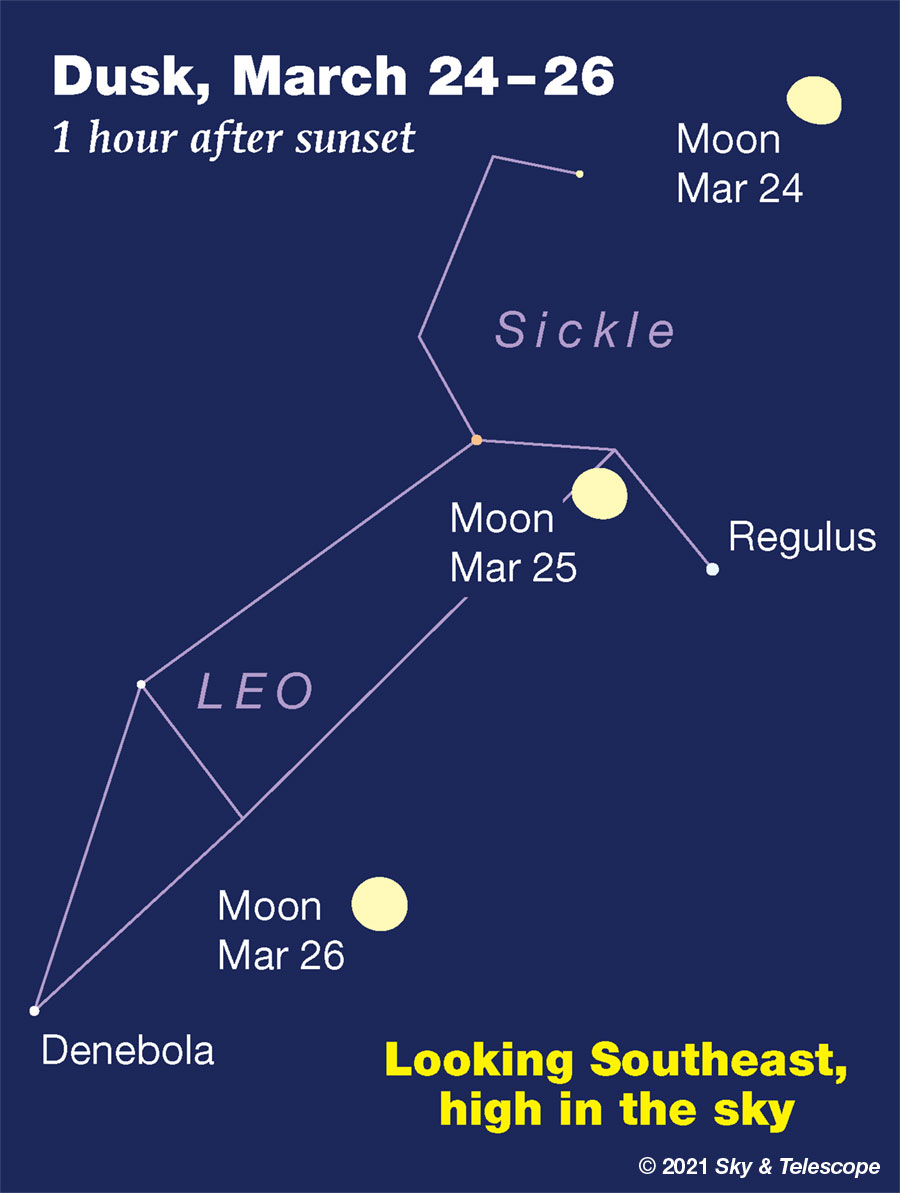8th-magnitude Nova in Cassiopeia. Nova Cassiopeiae 2021, now also known as V1405 Cassiopeiae, continues to hold at about magnitude 7.8 as of March 24th, after it was discovered at 9.6 on March 18th. For finder charts and more info see Bright Nova Erupts in Cassiopeia. Moonlight will give you trouble with binoculars, even large ones, but the moonlight will be gone from the early-evening sky starting on the 30th.
For a light curve with the most up-to-date brightness measurements, go to aavso.org and under "Pick a Star", enter "V1405 Cas" and choose "Plot a light curve". There, visual observers' estimates are the open black circles, and photoelectric V magnitudes are the green squares. (Under "Preferences" you can choose calendar dates instead of Julian Days.)
FRIDAY, MARCH 19
■ The Moon this evening shines with Mars and Aldebaran, which look almost identical as shown below.

■ Pollux and Castor in Gemini pass nearly overhead around 7 p.m. this week if you live in the world's mid-northern latitudes. They go smack overhead as seen from near latitude 30° north: Austin, Houston and the US Gulf Coast, as well as northernmost Africa, Tibet, and Shanghai.
The "twin" heads of the Gemini figures are fraternal twins at best. Pollux is visibly brighter than Castor and pale orange. And as for their physical nature? They're not even the same species.
Pollux is a single orange giant. Castor is a binary pair of two smaller, hotter, white main-sequence stars, a fine double in amateur telescopes. If Pollux were a basketball, Castor A and B would be a tennis ball and a baseball about a half mile apart.
Moreover, each Castor star is closely orbited by an unseen red dwarf — a marble in our scale model just a foot or so from each of the two bright primaries.
And a very distant tight pair of red dwarfs, Castor C, is visible in amateur scopes as a single, 10th-magnitude speck 70 arcseconds south-southeast of the main pair. In our scale model, they would be a pair of marbles about 3 inches apart at least 10 miles from Castor A and B.
Read more in Fred Schaaf's "Gemini's Like and Unlike Twins" in the March Sky & Telescope, page 45.
SATURDAY, MARCH 20
■ Now the Moon shines between the horn tips of Taurus, Beta and Zeta Tauri, as shown above. These two stars form a long rectangle with Mars and Aldebaran: a temporary asterism special to mid-March 2021.
■ Earth crosses the March equinox point on its orbit at 5:37 a.m. EDT on this date. This when the Sun crosses the equator (both Earth's equator and, equivalently, the celestial equator), heading north. Spring begins in the Northern Hemisphere, fall in the Southern Hemisphere. And no, eggs don't balance today any better than they usually do, in case someone tries to tell you that.
SUNDAY, MARCH 21
■ First-quarter Moon. The Moon shines in the feet of Gemini, high above Orion in early evening.
■ The brightest asteroid, 4 Vesta, continues creeping across the rear flank of Leo this week at a binocular-easy magnitude 6.1. Use the finder chart with the article about Vesta in the March Sky & Telescope, page 48.
MONDAY, MARCH 22
■ Now the Moon, just past first quarter, shines high under Pollux and Castor in early evening. Far below the Moon is the huge Winter Triangle: Procyon on the left, orange Betelgeuse on the right in Orion's shoulder, and brilliant Sirius below them.
TUESDAY, MARCH 23
■ After dark look right of the Moon for Pollux, then Castor. Farther below the Moon is Procyon, the Little Dog Star. Even farther below Procyon is bright white Sirius, the original Dog Star itself.
WEDNESDAY, MARCH 24
■ The bright gibbous Moon shines upper right of Leo's Sickle asterism in early evening, as shown below.
By 10 or 11 p.m. the Moon shines directly to the right pf Leo.

■ Algol shines at its minimum brightness in early evening, while it's still fairly high in the northwestern sky, for the Mountain and Pacific time zones of North America. Its mid-eclipse is predicted for 7:55 p.m. Pacific Daylight Time. In another month Algol will be essentially gone for the season.
THURSDAY, MARCH 25
■ This evening the gibbous Moon shines at the Sickle of Leo, more or less between Regulus to its lower right and Algieba (Gamma Leonis) to its upper left, as shown above (depending on your location).
This line of three turns vertical, with the Moon still near its middle, by about 1 a.m.
■ Also this evening, a line drawn from Aldebaran through Mars points straight to Capella far beyond.
FRIDAY, MARCH 26
■ Now that spring is under way, Orion has taken up his early-spring posture in the southwest during evening. He's tipping westward, and his three-star Belt is turning horizontal.
When does Orion's Belt appear exactly horizontal? That depends on where you live east-west in your time zone, and on your latitude. How well can you time this event? If you're near your time zone's standard longitude, expect it around 8:40 this evening (daylight-saving time). . . more or less.
SATURDAY, MARCH 27
■ The Moon this evening is less than a day from being exactly full. After dark, look far to its lower left, by three or four fists at arm's length, for bright yellow Arcturus making its way up the eastern sky.
By 9 or 10 p.m. daylight-saving time, look two or three fists below the Moon for Spica now on the rise.
■ Meanwhile on the other side of the sky, the signature fall-and-winter constellation Cassiopeia retreats down after dark. Look for it fairly low in the north-northwest. It's standing roughly on end.
For skywatchers at mid-northern latitudes and above, Cassiopeia is circumpolar, never going away completely. After midnight it's at its lowest due north, lying not quite horizontally.
This Week's Planet Roundup
Mercury has sunk out of sight into the glow of sunrise.
Venus is out of sight in conjunction with the Sun.
Mars (magnitude +1.2, in Taurus) shines high in the west after dark. Mars is nearly the twin of Aldebaran to its lower left, in both brightness and in color. Mars this week is passing north of Aldebaran, giving it a wide 7° berth for several days running. They're closest (6.9°) on March 20th.
In a telescope Mars is a mere 5½ arcseconds wide: a tiny bright blob too small for any surface detail.
Jupiter and Saturn have been slowly emerging into dawn view for the last three weeks. Look low in the east-southeast about 50 or 40 minutes before your local sunrise time. Saturn is the higher of the two, but it's much dimmer at magnitude +0.7. Jupiter shines at magnitude –2.0 (not counting the atmospheric extinction for something so low); look for it some 11° to Saturn's lower left. That's about a fist at arm's length.
Uranus (magnitude 5.8, in western Aries) is sinking away low in the west right after the end of evening twilight.
Neptune is hidden in the glare of the Sun.
All descriptions that relate to your horizon — including the words up, down, right, and left — are written for the world's mid-northern latitudes. Descriptions that also depend on longitude (mainly Moon positions) are for North America.
Eastern Daylight Time, EDT, is Universal Time minus 4 hours. Universal Time is also known as UT, UTC, GMT, or Z time. For all the down-and-dirty details see Time and the Amateur Astronomer.
Want to become a better astronomer? Learn your way around the constellations. They're the key to locating everything fainter and deeper to hunt with binoculars or a telescope.
This is an outdoor nature hobby. For an easy-to-use constellation guide covering the whole evening sky, use the big monthly map in the center of each issue of Sky & Telescope, the essential magazine of astronomy.
Once you get a telescope, to put it to good use you'll need a detailed, large-scale sky atlas (set of charts). The basic standard is the Pocket Sky Atlas (in either the original or Jumbo Edition), which shows stars to magnitude 7.6.

Next up is the larger and deeper Sky Atlas 2000.0, plotting stars to magnitude 8.5; nearly three times as many. The next up, once you know your way around, are the even larger Interstellarum atlas (stars to magnitude 9.5) or Uranometria 2000.0 (stars to magnitude 9.75). And be sure to read how to use sky charts with a telescope.
You'll also want a good deep-sky guidebook, such as Sky Atlas 2000.0 Companion by Strong and Sinnott, or the bigger (and illustrated) Night Sky Observer's Guide by Kepple and Sanner.
Can a computerized telescope replace charts? Not for beginners, I don't think, and not on mounts and tripods that are less than top-quality mechanically, meaning heavy and expensive. And as Terence Dickinson and Alan Dyer say in their Backyard Astronomer's Guide, "A full appreciation of the universe cannot come without developing the skills to find things in the sky and understanding how the sky works. This knowledge comes only by spending time under the stars with star maps in hand."
![]() Audio sky tour. Out under the evening sky with your
Audio sky tour. Out under the evening sky with your
earbuds in place, listen to Kelly Beatty's monthly
podcast tour of the heavens above. It's free.
"The dangers of not thinking clearly are much greater now than ever before. It's not that there's something new in our way of thinking, it's that credulous and confused thinking can be much more lethal in ways it was never before."
— Carl Sagan, 1996
"Facts are stubborn things."
— John Adams, 1770
 2
2









Comments
mary beth
March 19, 2021 at 1:06 pm
Nice article from The Old Farmer’s Almanac....especially fun for families new to stargazing!
https://www.almanac.com/moon-flies-high-overhead-equinox?trk_msg=TRVP5MGTUM74RARJ97S3IAD99C&trk_contact=0OIENRP8KMAE0Q6GNE13UJJPQK&trk_sid=KJNI8S23JVH91GV8OG1952UA2S&utm_source=Listrak&utm_medium=Email&utm_term=The+Moon+Flies+High+Overhead+on+the+Equinox+(title)&utm_campaign=Companion+Daily
You must be logged in to post a comment.
Rod
March 19, 2021 at 11:45 pm
mary beth, nice link. I was out for a couple of hours this evening in my east pasture viewing Castor, Moon, Mars, M42, and Rigel. Lovely time shortly after 8:00 PM EDT. I enjoyed views of Castor as a double star at 158x using my 10-inch. The Moon and Mars in Taurus were lovely using my 2-inch eyepiece at 34x. Mars distinct gibbous shape planet at 158x and orange-red color. 5 stars visible in the Trapezium in M42 at 158x. Numerous lunar craters along terminator line visible and earthshine too. Viewing the nearly First Quarter Moon using the 2-inch eyepiece was excellent, especially with earthshine visible. As the report here states, "And a very distant tight pair of red dwarfs, Castor C, is visible in amateur scopes as a single, 10th-magnitude speck 70 arcseconds south-southeast of the main pair. In our scale model, they would be a pair of marbles about 3 inches apart at least 10 miles from Castor A and B." I viewed these stars tonight. Castor A and B, 3.1" angular separation and easy double at 158x using the XT10i. Castor is 15.6 pc so 3.1" = 48.36 au separation between the two stars. Rigel is about 260 pc and 9.5" angular separation so about 2470 au separation between the stars.
You must be logged in to post a comment.
You must be logged in to post a comment.